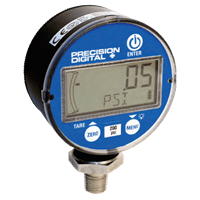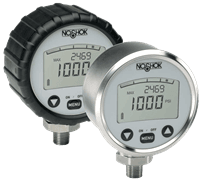Digital Pressure Gauges
Digital pressure gauges used to measure and display the pressure of a gas or liquid in a system, using electronic sensors and digital technology. Unlike traditional mechanical gauges that rely on analog pointers and dials, digital pressure gauges provide pressure readings on an LCD or LED screen, offering higher accuracy, more features, and greater versatility for various industrial, commercial, and laboratory applications.
/PG7-Digital-Pressure-Gauge/Thumbs/200_main_PG7_Front.png)
/PG5-Digital-Pressure-Gauge/Thumbs/200_main_PG5_Front.png)
/PG2-Digital-Pressure-Gauge/Thumbs/200_main_AP_PG2_Digital_Pressure_Gauge.png)
/PG10-Digital-Pressure-Gauge/Thumbs/200_main_PG10_Front.png)


Digital pressure gauges represent a modern and versatile solution for measuring and monitoring pressure in a wide range of applications. Their high accuracy, easy readability, advanced features, and connectivity options make them essential tools in industries where precise pressure control is vital. Whether for process control, testing, calibration, or safety monitoring, digital pressure gauges provide a reliable and efficient means of maintaining pressure standards and ensuring optimal system performance.
The core component of a digital pressure gauge is an electronic sensor that detects and measures the fluid pressure. Common types of sensors used include the strain gauge sensors which measure pressure by detecting the deformation (strain) of a diaphragm or membrane when pressure is applied, wherein the deformation changes the electrical resistance, which is converted into a readable pressure value. Piezoelectric sensors generate an electrical charge in response to applied pressure, and are suitable for dynamic pressure measurements, such as vibrations or rapid pressure changes. Capacitive sensors measure changes in capacitance caused by pressure-induced deflection of a diaphragm, and are often used in low-pressure applications due to their high sensitivity.
Other components include a microprocessor that receives the signal from the pressure sensor, processes the data, and converts it into a digital reading. The microprocessor can also apply calibration factors, temperature compensation, and filtering to ensure accurate and stable readings. The pressure reading is shown on an LCD or LED display, typically in various units (PSI, bar, kPa, etc.) as per user preference. The display may also show other useful information, such as battery life, maximum and minimum recorded pressures, or error messages. Digital pressure gauges require a power source, usually a battery (often rechargeable) or, in some cases, external power from an electrical supply. Digital gauges often include buttons for powering the device on or off, changing the pressure units, setting alarms, or accessing other features like peak pressure readings or data logging. Some digital pressure gauges offer data output ports (such as USB or RS-232) for connecting to computers, data loggers, or other devices, enabling remote monitoring, data analysis, and integration with control systems.
Digital pressure gauges typically offer superior accuracy compared to mechanical gauges, often in the range of ± 0.1 % to ± 0.25 % of full-scale reading, making them suitable for applications requiring precise measurements. Users can easily switch between different pressure units (e.g., PSI, bar, Pa, kPa) without needing to recalibrate the gauge. Many digital pressure gauges can store pressure readings over time, allowing for trend analysis, historical data review, and performance monitoring. Some models have a peak hold feature that records the highest pressure reached over a period, useful for capturing transient pressure spikes. Digital gauges can compensate for temperature changes that might affect the pressure reading, providing more stable and accurate measurements. Digital pressure gauges can be programmed to trigger visual, audible, or remote alarms when pressure readings exceed or fall below pre-set thresholds, enhancing safety and control. Advanced digital pressure gauges may offer wireless connectivity (Bluetooth, Wi-Fi) for remote monitoring and integration with other systems or devices.
Digital pressure gauges are very popular in industrial process control where they're used in chemical plants, refineries, and food processing industries to monitor and control pressure within critical equipment like reactors, pipelines, and tanks, ensuring optimal performance and safety. These devices are ideal for use in laboratories, quality control, and field service applications where high accuracy and reliability are required for calibrating other pressure instruments or testing equipment. Digital pressure gauges are commonly used in hydraulic and pneumatic systems to ensure proper pressure is maintained in equipment such as pumps, compressors, and actuators, preventing damage and ensuring efficient operation. The aerospace and automotive industries use digital pressure gauges to measure and monitor pressures in aircraft systems, vehicle tires, brakes, and engines, providing accurate and reliable data for safety and performance optimization. Medical applications, including ventilators, oxygen tanks, and blood pressure monitors, where precise pressure control is critical for patient care, are another important area of use. Environmental monitoring is yet another application of digital pressure gauges, assisting environmental studies and research in measuring atmospheric pressure, water levels, and other pressure-related data points in various environments.
Digital pressure gauges provide more accurate and reliable pressure measurements compared to most mechanical gauges, making them ideal for applications where precision is critical. The digital display provides clear and unambiguous readings, eliminating the parallax errors that can occur with analog gauges. A range of features like multiple units of measure, data logging, and alarms, providing greater functionality and adaptability to different applications. The ability to connect with other devices and systems enables better data management, remote monitoring, and integration into automated control systems. Many digital pressure gauges are designed to withstand harsh environments, with rugged casings, waterproofing, and resistance to shock and vibration.